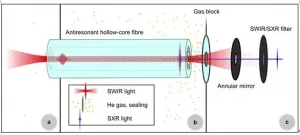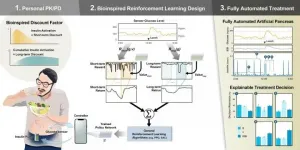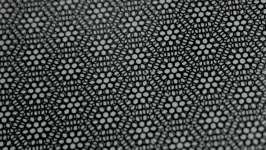'Walking' molecule superstructures could help create neurons for regenerative medicine
3D-printed novel biomaterial mimics properties of living tissues
2021-02-23
(Press-News.org) Imagine if surgeons could transplant healthy neurons into patients living with neurodegenerative diseases or brain and spinal cord injuries. And imagine if they could "grow" these neurons in the laboratory from a patient's own cells using a synthetic, highly bioactive material that is suitable for 3D printing.
By discovering a new printable biomaterial that can mimic properties of brain tissue, Northwestern University researchers are now closer to developing a platform capable of treating these conditions using regenerative medicine.
A key ingredient to the discovery is the ability to control the self-assembly processes of molecules within the material, enabling the researchers to modify the structure and functions of the systems from the nanoscale to the scale of visible features. The laboratory of Samuel I. Stupp published a 2018 paper in the journal Science which showed that materials can be designed with highly dynamic molecules programmed to migrate over long distances and self-organize to form larger, "superstructured" bundles of nanofibers.
Now, a research group led by Stupp has demonstrated that these superstructures can enhance neuron growth, an important finding that could have implications for cell transplantation strategies for neurodegenerative diseases such as Parkinson's and Alzheimer's disease, as well as spinal cord injury.
"This is the first example where we've been able to take the phenomenon of molecular reshuffling we reported in 2018 and harness it for an application in regenerative medicine," said Stupp, the lead author on the study and the director of Northwestern's Simpson Querrey Institute. "We can also use constructs of the new biomaterial to help discover therapies and understand pathologies."
A pioneer of supramolecular self-assembly, Stupp is also the Board of Trustees Professor of Materials Science and Engineering, Chemistry, Medicine and Biomedical Engineering and holds appointments in the Weinberg College of Arts and Sciences, the McCormick School of Engineering and the Feinberg School of Medicine.
The paper was published today (Feb. 22) in the journal Advanced Science.
Walking molecules and 3D printing
The new material is created by mixing two liquids that quickly become rigid as a result of interactions known in chemistry as host-guest complexes that mimic key-lock interactions among proteins, and also as the result of the concentration of these interactions in micron-scale regions through a long scale migration of "walking molecules."
The agile molecules cover a distance thousands of times larger than themselves in order to band together into large superstructures. At the microscopic scale, this migration causes a transformation in structure from what looks like an uncooked chunk of ramen noodles into ropelike bundles.
"Typical biomaterials used in medicine like polymer hydrogels don't have the capabilities to allow molecules to self-assemble and move around within these assemblies," said Tristan Clemons, a research associate in the Stupp lab and co-first author of the paper with Alexandra Edelbrock, a former graduate student in the group. "This phenomenon is unique to the systems we have developed here."
Furthermore, as the dynamic molecules move to form superstructures, large pores open that allow cells to penetrate and interact with bioactive signals that can be integrated into the biomaterials.
Interestingly, the mechanical forces of 3D printing disrupt the host-guest interactions in the superstructures and cause the material to flow, but it can rapidly solidify into any macroscopic shape because the interactions are restored spontaneously by self-assembly. This also enables the 3D printing of structures with distinct layers that harbor different types of neural cells in order to study their interactions.
Signaling neuronal growth
The superstructure and bioactive properties of the material could have vast implications for tissue regeneration. Neurons are stimulated by a protein in the central nervous system known as brain-derived neurotrophic factor (BDNF), which helps neurons survive by promoting synaptic connections and allowing neurons to be more plastic. BDNF could be a valuable therapy for patients with neurodegenerative diseases and injuries in the spinal cord but these proteins degrade quickly in the body and are expensive to produce.
One of the molecules in the new material integrates a mimic of this protein that activates its receptor known as Trkb, and the team found that neurons actively penetrate the large pores and populate the new biomaterial when the mimetic signal is present. This could also create an environment in which neurons differentiated from patient-derived stem cells mature before transplantation.
Now that the team has applied a proof of concept to neurons, Stupp believes he could now break into other areas of regenerative medicine by applying different chemical sequences to the material. Simple chemical changes in the biomaterials would allow them to provide signals for a wide range of tissues.
"Cartilage and heart tissue are very difficult to regenerate after injury or heart attacks, and the platform could be used to prepare these tissues in vitro from patient-derived cells," Stupp said. "These tissues could then be transplanted to help restore lost functions. Beyond these interventions, the materials could be used to build organoids to discover therapies or even directly implanted into tissues for regeneration since they are biodegradable."
INFORMATION:
The work was supported by the Center for Regenerative Nanomedicine at Northwestern's Simpson Querrey Institute, graduate research fellowships through the National Science Foundation and an American Australian Association Fellowship.
The paper is titled "Superstructured Biomaterials Formed by Exchange Dynamics and Host-Guest Interactions in Supramolecular Polymers."
[Attachments] See images for this press release:

ELSE PRESS RELEASES FROM THIS DATE:
2021-02-23
Bright, coherent soft X-ray radiation (SXR) is used in many scientific applications such as advanced absorption spectroscopy or lens-less imaging, and in fundamental research e.g. to produce extremely short isolated optical pulses. Therefore, the generation, control, and detection of this type of short-wavelength light is highly important in fields like fundamental atomic physics, solid-state physics, the semiconductor industry, material science and biology.
To date, high photon flux in the soft X-ray spectral region is mostly delivered by large-scale facilities like synchrotrons or free electron lasers. An alternative is to use high-order harmonic generation (HHG) sources, which are currently driven by pulsed laser systems with ...
2021-02-23
Diabetes is on the rise worldwide. It is a permanent condition that requires care over a life time. To help manage it, an artificial pancreas system, which automatically measures blood sugar levels to infuse the appropriate amount of insulin into the blood, has now become smarter thanks to AI learning.
A research team, led by Professor Sung-Min Park and Ph.D. candidate Seunghyun Lee and M.S. candidate Jiwon Kim of POSTECH's Department of Convergence IT Engineering and Electrical Engineering, has newly developed a reinforcement learning (RL) based AI algorithm that calculates the ...
2021-02-23
Luxembourg, 23 February 2021 - At an online European Parliament workshop hosted by Deirdre Clune MEP (Ireland), Alzheimer Europe launched a new report "Data Sharing in Dementia Research", which reviews recent changes in EU research policy and sets out recommendations to improve data sharing in dementia research.
In this report, Alzheimer Europe evaluates the legal and policy landscapes that dementia researchers have had to navigate since the launch of Horizon 2020 in 2013. The report identifies key barriers and enablers for data sharing. It maps the Horizon 2020 dementia research portfolio, assessing the scale of EU investment in dementia research and the use of clinical ...
2021-02-23
Helsinki, Finland--Technology helps humans maintain connections, get work done, and relax after a long day. How it can best improve the lives of animals, particularly those in captivity, however, has remained an open question.
Scientists from Aalto University, in collaboration with Korkeasaari Zoo, have designed and built an on-demand video device for white-faced saki monkeys to activate as and when they like. While enrichment systems for zoo animals have been around for some time, very few offer animals the ability to choose when and how they use the device, even though choice and control are known to promote animal welfare.
'We were very much interested in how we can give animals control over their ...
2021-02-23
U.S. policies in the Middle East are built on outdated "legacy" aid packages, massive arms sales and a disproportionate focus on the Iranian threat that fail to advance American interests - or help the region's people - and need to be rethought, according to a new RAND Corporation report.
The United States devotes an overwhelming share of foreign military financing to just three countries - Israel, Egypt and Jordan, which received 81% of the $6 billion spent globally in 2019. If policymakers were to pursue an alternative strategy outlined by RAND researchers, ...
2021-02-23
Graphene, a two-dimensional material composed exclusively of carbon, has revealed extraordinary properties, including thermal and electrical conductivity, transparency, and flexibility. When combined, these properties become particularly interesting in the age of touch screens and flexible electronics! 'Unlike 3D materials, graphene has a height reduced to the ultimate dimension of the atom. It's therefore a carbon atom plane,' explains Prof. Jean-Christophe Charlier, a specialist in nanoscopic physics at the Institute of Condensed Matter and Nanosciences of UCLouvain.
In a study published in Nature, the scientist and his team dissected the behaviour of electrons when two layers of graphene superimposed at an ...
2021-02-23
Its muscular body shape and large pectoral fins are perfect for long-distance travel, yet movement patterns of the whitespotted eagle ray (Aetobatus narinari) remain a mystery. Researchers from Florida Atlantic University's Harbor Branch Oceanographic Institute in collaboration with Mote Marine Laboratory & Aquarium, the University of Florida and the Florida Fish and Wildlife Conservation Commission, are the first to conduct a multiyear study examining large-scale movements of whitespotted eagle rays in United States waters.
Between 2016 and 2018, scientists fitted 54 rays with acoustic transmitters ...
2021-02-23
Doha, Qatar - (February 23, 2021) - A group of researchers at Qatar Foundation have reported the first and largest genetic association study in the Middle East, that has been published online in Nature Communications - a leading a peer-reviewed, open access, scientific journal published by Nature Research.
The study titled "Whole genome sequencing in the Middle Eastern Qatari population identifies genetic associations with 45 clinically relevant traits" highlights a vital piece of information wherein now there is a better understanding of the genetic risk factors that are specific to the Arab population, including those that are shared with other ethnicities.
Qatar was among the first countries to launch its own large-scale, national genome project. Qatar Genome ...
2021-02-23
A recent genetic study at the University of Helsinki provides new information on the occurrence of a DVL2 gene defect associated with a screw tail and its relevance to canine constitution and health. The variant was found in several Bulldog and Pit Bull type breeds, and it was shown to result in caudal vertebral anomalies and shortening of the muzzle. The DLV2 variant may also affect the development of the heart.
Dog breeding is often focused on appearance. In some breeds, the ideal body shape is bulky, with a broad head and short muzzle, short legs and a very short and kinked tail, also known as a "screw tail". In a previous study in the United States, screw tail was linked to a variant in the DVL2 gene. The variant has become enriched ...
2021-02-23
According to recent estimates, there will be roughly 10 billion people to feed in 2050. Agricultural production will need to increase by almost 56% to guarantee food security globally, without converting more land for agriculture (in line with environmental and climate targets). This unprecedented challenge has ushered in the era of "smart agriculture," which promises to revolutionize food production by combining agricultural techniques with information technology, automation, and artificial intelligence. This new era, called "Agriculture 4.0," could ensure sustainable food production for the entire world. However, as communities gradually embrace smart agriculture, it is important to understand how to manage the security and privacy risks associated with the integration of ...
LAST 30 PRESS RELEASES:
[Press-News.org] 'Walking' molecule superstructures could help create neurons for regenerative medicine
3D-printed novel biomaterial mimics properties of living tissues






